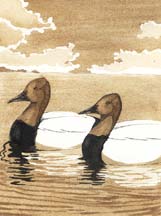 In Season ~ Canvasbacks
In Season ~ Canvasbacks
by Gary Pendleton
Where I come from, a small community at the northern end of the Chesapeake Bay, there was once a restaurant called The Canvasback. The town is Perryville in Cecil County, across the water from Havre De Grace at the place where the Susquehanna River becomes Chesapeake Bay.
The waters around there are known to many as the Susquehanna flats. Time was, the shallow waters of the flats supported tremendous winter populations of waterfowl. Wild celery and other kinds of submerged aquatic vegetation grew abundantly in the shallow Bay waters, and that is what brought the ducks. Hunters, too.
The scientific name for the canvasback duck is Aythya valisineria, after one of their preferred foods, Vallisneria americana or wild celery. Canvasbacks prefer a diet that contains a high percentage of plant material. This diet apparently gives the bird a superior flavor as they are considered the best tasting of all ducks.
Chesapeake Bay once hosted the largest wintering population of canvasback ducks. Since the 1970s, a serious decline in the quantity of Chesapeake Bay grasses has contributed to major declines in winter duck populations. The lower Mississippi now claims the largest wintering population of this emblematic Maryland bird.
Canvasbacks gather on the water in large groups called rafts. Huge rafts of ducks on the Susquehanna flats made the upper Bay a mecca for duck hunters. The fertile hunting grounds generated demand for decoys. That demand was met by a group of talented carvers from Cecil and Harford counties. The Decoy Museum in Havre De Grace is worth a visit for anyone who would like to see examples of their work. Exhibits there also tell the history of duck hunting around the upper Chesapeake. The museum offers panoramic views of the water, and it is a short walk to the historic Concord Point Lighthouse.
Canvasbacks have not disappeared from local waters. In some years, they still come in large numbers. The recent cold weather could be the harbinger of a good duck-spotting season. The weather seems to have spurred canvasbacks, scaup and other Bay ducks to head south from their northern prairie breeding grounds.
The many different species of Bay ducks are worth checking out. If you have a decent set of binoculars or a spotting scope, you could be rewarded with some excellent views. I have seen large rafts of them at North Beach.
Last year’s very mild winter meant that there were very few ducks to be seen. It is good to have them back.